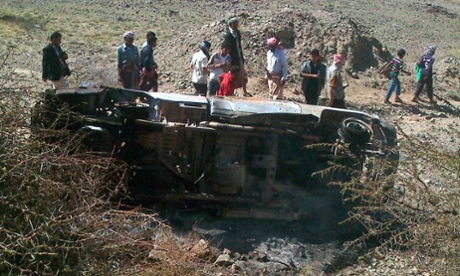
When children in Yemen try to ignore their bedtimes, their parents have a new warning to scare them into obedience: a drone will come for them.
Farea al-Muslimi, a young Yemeni activist and journalist whose hometown was subjected to a drone strike, shared that anecdote with a Senate panel last year. He meant to impress upon US politicians what he called the “psychological fear and terror” Yemenis feel from a campaign the Obama administration is now citing as a model for its unfolding war against Islamic State (Isis).
The other counter-terrorism effort cited by the administration for the anti-Isis war is across the Gulf of Aden, in Somalia. In both countries, the US uses drone strikes, special operations raids, the occasional cruise missile and support for proxy militaries and governments to combat al-Qaida’s regional affiliates.
In his Wednesday speech, Obama said his template against Isis – “taking out terrorists who threaten us, while supporting partners on the frontlines” – was one he has “successfully pursued in Yemen and Somalia for years”.
Yet despite years of strikes and billions spent on shoring up local forces, no end is in sight against either al-Qaida in the Arabian Peninsula (AQAP) in Yemen or al-Shabaab in Somalia – an ominous indicator for a war against the far more capable and financially flush Isis.
One apparent exception to the Yemen-Somalia model of Obama’s emerging anti-Isis strategy is an explicit forswearing of US ground combat forces in Iraq and Syria, although Obama has sent significant numbers of special operations “advisers” to Iraq.
But in both Yemen and Somalia, al-Qaida’s affiliates have proven durable.
Obama has launched 99 air strikes against AQAP according to a tally kept by the Long War Journal website, including 16 this year. Nearly 600 people have died in those strikes, although determining how many are civilians is notoriously difficult. (Four members of the dead are Americans – three of whom don’t appear to have been directly targeted; one of those was a 16-year-old boy, Abdulrahman al-Awlaki.) The war, never authorised by Congress, ratcheted up after AQAP’s failed attempts in 2009 and 2010 to detonate passenger and cargo planes.
While AQAP has surely lost significant leaders, it survives. Nearly five years after its attempted Christmas Day bombing, it is “still active in its efforts to attack the homeland,” Homeland Security secretary Jeh Johnson said on Wednesday. The deputy director of the National Counterterrorism Center testified on Wednesday that AQAP remains the single greatest terrorist threat to the US domestically.
In Somalia, al-Shabab’s fortunes have taken a downward turn in recent years, the result of US strikes, support for African forces propping up Somalia’s weak government, and its own missteps after the 2011 drought. While its own threat to the US mainland has scarcely manifested, it has withstood years of sometimes intense fighting to export terrorism regionally -- most notoriously through last year’s brutal assault on Nairobi’s Westgate mall, which murdered at least 67 people.
The US scored a victory against al-Shabaab this month. A September 1 air strike killed Ahmed Godane, the organization’s leader and the man who turned al-Shabaab into al-Qaida’s east African affiliate.
Yet it is unknown whether that blow will be decisive. Godane’s successor in al-Shebaab, Abu Ubaidah, is said to be a hardliner who reportedly oversaw the killing of a prominent American member, Omar Hammami, who had fallen out with the group. “It would be foolish to underestimate their staying power,” Chatham House analyst Ahmed Soliman told the Wall Street Journal.
US officials note that their efforts in Yemen and Somalia are political as well as military. Yemen in particular is a frequent transit point for White House counterterrorism director Lisa Monaco and her predecessor John Brennan, now the director of the CIA. Monaco was last in Yemen on Saturday, where a White House readout said she showed Washington’s support for President Abd Rabbu Mansour Hadi’s pursuit of “peace, stability and prosperity”.

Yet all are in short supply. Hadi is locked in a major struggle with Houthi separatists in the north, which the International Crisis Group on Wednesday said risks pulling his government “into a crisis that it cannot win militarily, especially while it fights an emboldened al-Qaida branch”.
The same organization warned in June of a “long war” against al-Shabaab in Somalia, where “socio-political dysfunction” persists. Human Rights Watch has accused the various combatants in Somalia’s violent politics, including al-Shabaab, of “serious violations of international law,” including “indiscriminate attacks, sexual violence, and arbitrary arrests and detention”.
Speaking to reporters on Wednesday ahead of Obama’s speech, a senior US official said it was not possible to say when the fight against Isis would end, and conceded that its template efforts in Yemen and Somalia persist.
“This is going to look like the type of counterterrorism campaign that we’ve waged against different al-Qaida affiliates. So, for instance, in Yemen and Somalia, we have been able to contain the threat to the US homeland, degrade those terrorist affiliate organizations, and in some instances decapitate their leadership, but we’re still at it.” the official said.
“And I think there is a rhythm that people are accustomed to in Yemen and Somalia, where we are providing support for security forces on the ground, and we are taking air strikes as necessary.”

















